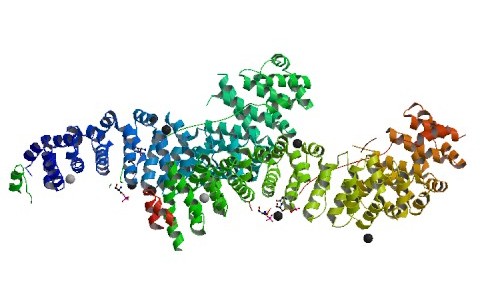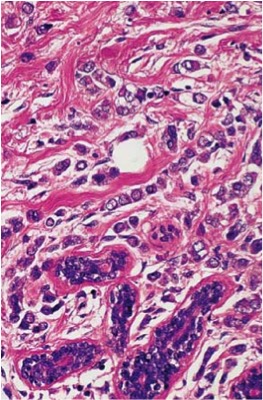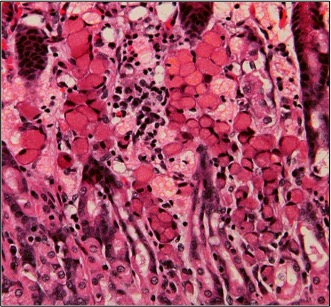Women from HDGC families should be followed by oncologists or breast surgeons and have clinical breast exams regularly. Screening with yearly breast MRI, which can be combined with mammograms, is recommended starting at age 30. There is a possible role for preventive hormone-blocking medications to reduce the risk of lobular breast cancer in CDH1 mutation carriers. If there are many cases of breast cancer in the family, prophylactic mastectomy may also be considered, but mastectomy is not routinely recommended.

Scientific Background

The role of the E-cadherin protein affected by CDH1 gene mutations is adhesion of adjacent cells in certain tissues of the body. In patients with a CDH1 gene mutation, the loss of E-cadherin is thought to lead to invasive tumors, most often in the lining of the stomach. However, a form of breast cancer called lobular breast cancer has also been associated with the CDH1 gene mutation.
In the general population, lobular breast cancer occurs much less frequently than ductal breast cancer. However, lobular carcinoma is the type of breast cancer that can be associated with CDH1 mutations, and it may be difficult to diagnose (much like hereditary diffuse gastric cancer). The same type of cancer cells, called signet ring cells, can be found in both lobular breast cancer and diffuse gastric cancer. This helps to solidify a relationship between the CDH1 gene mutation and an increased risk of both diffuse gastric cancer and lobular breast cancer. A patient with the CDH1 gene mutation who develops both gastric cancer and lobular breast cancer is considered to have two separate cancers (in other words, cancer does not start in one location and spread to the other). To date, lobular breast cancer is the only cancer besides gastric that is known to occur at increased rates in families affected by a CDH1 gene mutation.
Risk of Developing Lobular Breast Cancer
In females with a known CDH1 gene mutation, the risk for developing lobular breast cancer by age 80 has been estimated at 42%. However, scientific studies vary in risk determination due to the small number of patients affected by the CDH1 gene mutation.
Download more information regarding Lobular Breast Cancer Genetic and Non-Genetic Risk Factors
Screening Options

Because lobular breast cancer is difficult to detect due to its diffuse pattern of growth, breast surveillance is of the utmost importance for females in HDGC families. It is recommended that females affected by a CDH1 gene mutation meet with a breast oncologist or breast surgeon for yearly clinical breast exams and to talk about screening for lobular breast cancer. Screening recommendations also include screening breast MRIs beginning at age 30. Medication therapy is also a consideration in the prevention and risk reduction of lobular breast cancer. Some patients may consider preventative mastectomy as another option, but this is not routinely recommended for CDH1 mutation carriers.
Mastectomy Tips & Experiences
- Be prepared to not be able to move your arms after surgery, for at least a week. This surprised me the most.
- Have someone at home with you when you leave the hospital. Simple tasks such as pouring milk, or even opening the refrigerator will be difficult at first. Also, most housework will be off-limits to you. No lifting, not repetitive motion such as wiping up a spill, and most push/pull motions will be difficult.
- Have some comfortable button-down shirts to wear while you recover as pulling anything over your head will be just about impossible for a while.
- Get some comfortable pillows, a lot of them, to help prop you up when you sleep. You will only be able to sleep on your back, and getting up from a completely flat position is very difficult without using your arms.
- Try to eat healthy foods and don’t skip meals. You need your strength to heal.
- Make sure you have rides set up ahead of time for your post-op doctor appointments. You won’t be able to drive yourself for several weeks.
- When friends ask what you need, ask for books, or plan to binge-watch a tv series on Netflix.
- You will need someone to assist you with washing your hair for a week or two. It will be difficult to reach your hands over your head to do it yourself.
- Take naps.
- Try to wean yourself off the pain meds sooner rather than later. They are powerful.
- Listen to your doctor’s advice before starting a stretching or exercise routine, but once you do have the go-ahead, work gently towards regaining your strength and mobility. It may be seen to take a long time, but it will come back.
- Be patient with yourself.
- Accept visitors so that you don’t get too bored
Patient Advocacy
Facing Our Risk Of Cancer Empowered (FORCE)
Fighting Hereditary Breast & Ovarian Cancer
References
Blair V, Martin I, Shaw D, Winship I, Kerr D, et al. Hereditary Diffuse Gastric Cancer: Diagnosis and Management. Clinical gastroenterology and hepatology. 2006;4:262-275.
Guilford P, Blair V, More H, Humar B. A short guide to hereditary diffuse gastric cancer. Hereditary Cancer in Clinical Practice. 2007;5(4):183-194.
Schrader KA, Masciari S, Boyd N, Wiyrick S, Kaurah P, et al. Hereditary diffuse gastric cancer: association with lobular breast cancer. Familial Cancer. 2008;7:73-82.
van der Post RS, Vogelaar IP, Carneiro F, et al. Journal of Medical Genetics. 2015;52:361-374.
Kaurah P, MacMillan A,Boyd N, Senz J, De Luca A, et al. Founder and recurrent CDH1 mutations in families with hereditary diffuse gastric cancer. Journal of the American Medical Association. 2007;297(21):2360-2372.
Vogelaar IP, van der Post RS, Carneiro F, Guilford P, Huntsman D, et al. Hereditary diffuse gastric cancer: updated clinical guidelines with an emphasis on germline CDH1 mutation carriers. J Med Genet. 2015;00:1-14.
Chun, YS, Lindor NM, Smyrk TC, Petersen BT, Burgart LJ, et al. Germline E-cadherin gene mutations: Is prophylactic total gastrectomy indicated? Cancer. 2001;92(1):181-187.